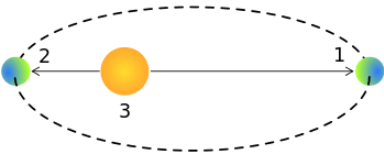Shloka: Trinabhicakramajaramanrvam yatreama visvabhuvanani tasthuh I
Meaning: The elliptical path through which all the celestial bodies move is Eternal and unslacken.
Source: Rg-veda Samhita, Mandalam 1, Suktam 164, Mantra 2(6000 BCE)
The above shloka talks about the final rites of Agnihotri (a person performing fire sacrifice as a daily ritual)
Aryabhatta also proposed the theory of elliptical path of Planets.
Shloka: Yada Te Haryataa Hari Vaavridhate Divedive Vishwa Bhuvani Aditte Yemir
Meaning: All planets remain stable because as they come closer to the sun due to attraction, their speed of coming closer increases proportionately.
Source: Rig Veda Samhita, Mandalam 8, Suktam 12, Mantra 28
The above shloka says:
All planets remain stable because as they come closer to the sun due to attraction, their speed of coming closer increases proportionately.
The connotation of this mantra
- Yada Te = When they
- Haryataa = Come closer through attraction
- Hari = Closeness
- Vaavridhate = Increases proportionately
- Divedive = continuously
- Vishwa Bhuvani = planets of the world
- Aditte = eventually
- Yemire = remain stable
This clearly says that:
1. The motion of planets around the sun is not circular, even though the sun is the center the force causing planets to move
2. The motion of planets is such that velocity of planets is in inverse relation with the distance between the planet and the sun.
Modern Age:
What is Ellipse?
Ellipse is a shape close to a circle. It’s a general assumption that all the planets move around the sun in the circular orbit. But that is not the case, most of the planets’ orbits are a stretched out circle or oval. Scientists coined this as Ellipse. All the celestial bodies that move around the sun have elliptical orbits. We have a special term called ‘eccentricity’ to explain how stretched out(oval) or how round the ellipse is.
If the eccentricity of an ellipse is close to one (0.1 to 0.9 ) the ellipse is long and if the eccentricity is close to zero, the ellipse is more like a circle.
 |
| Two bodies with similar mass orbiting around a common barycenter with elliptic orbits. |
A German scientist named Johannes Kepler, who belonged to the 17th century, was the one who proved that the planets move in the elliptical format. Kepler stated a few laws about the planetary motion. Kepler’s first law of planetary motion states that planets move in an elliptical orbit. His second law explains how planets move faster when they are close to the Sun (near perihelion) than when they are far away (near aphelion).
Example for Perihelion and aphelion
 |
| example of perihelion and aphelion |
- Planet at aphelion
- Planet at Perihelion
- Star (in our case, the Sun)
Thus, from the above discovery, it shows that our ancestors, corresponding to ‘Rig Veda Samhita, Mandalam 8, Suktam 12, Mantra 28’ stated above, knew about Aphelion and Perihelion way before the Modern Age.











